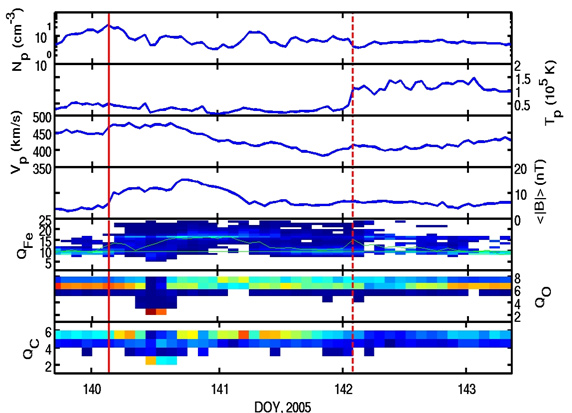
| ACE News Archives | ACE News #124 - August 26, 2009 |
Subscribe to ACE News |

Coronal mass ejections (CMEs) are explosive events which escape the Sun's corona, carrying solar material and energy into interplanetary space. The classic picture of a CME in the corona presents a "three-part structure", including a bright front at the leading edge indicating dense plasma, presumably due to the interaction of the CME with ambient plasma, a low density cavity - probably an embedded flux rope, and the so-called core which is often observed to be associated with the erupting prominence. Although there are in situ analogs to the first two CME parts, there are very few (<10) reports of cold, prominence-type plasma since solar wind measurements began. Three early studies (Schwenn 1980, Bame 1983, and Zwickl et al. 1982) identified cold material in ICMEs based on the presence of He+, thought to be evidence of the erupting prominence, including only three events with cold charge states in eight years. A similar event occurred in May 1998 (Skoug et al. 1999), for which Gloeckler et al. (1999) reported the first high-resolution observations of extremely low charge states of C, O and Fe in an ICME.
We have conducted the first long-time survey of such low charge states with the Solar Wind Ion Composition Spectrometer (SWICS) on ACE and discovered a substantially larger rate of ICMEs that include low charge-state plasmas. To identify cold material, we calculate the relative abundance of C2-3+/CTot, O4+/OTot, and Fe4-7+/FeTot. These charge states are generally not present in solar wind flows. Their presence indicates a source temperature of ~60,000 - 200,000 K, much lower than coronal temperatures (~106 K). For a threshold value, we require all three ratios to be more than one standard deviation above the mean to eliminate biases towards high-density flows. In addition, we require the speed of the low charge state ions to be within 15% of the He velocity.
An example of a cold ICME event is shown above. The top three panels show solar-wind proton density, temperature and speed from ACE/SWEPAM, followed by magnetic field magnitude from ACE/MAG. The bottom three panels show the charge state evolution for Fe, O, and C from SWICS. The shading indicates the relative ion density, with blue lowest and red highest. The solid/dashed vertical red lines mark the front/rear ejecta boundaries from Cane & Richardsons ICME list (http://www.ssg.sr.unh.edu/mag/ace/ACElists/ICMEtable.html). The green track labeled QFe shows the average Fe charge state (<QFe>). Outside of the ICME, Fe10+ is most abundant, while O is mostly in charge states 6+ and 7+ and C is mostly 5+ and 6+. However, near the front of the ejecta, the most abundant ions shift dramatically to states as low as C2+, O2+, and Fe5+. The ejecta contain both hot and cold plasma for all three species (see, e.g., the Fe16+ enhancement). For each species the cold plasma is confined to a fairly short period on DOY 140, 2005.
We find that these events are much more common than previously assumed: in almost 11 years we find 10 "cold ICME" events, ~5% of all ICMEs observed during this time.
This item was contributed by Susan Lepri and Thomas Zurbuchen of the University of Michigan. Address questions and comments to
Last modified 26 Aug 2009.